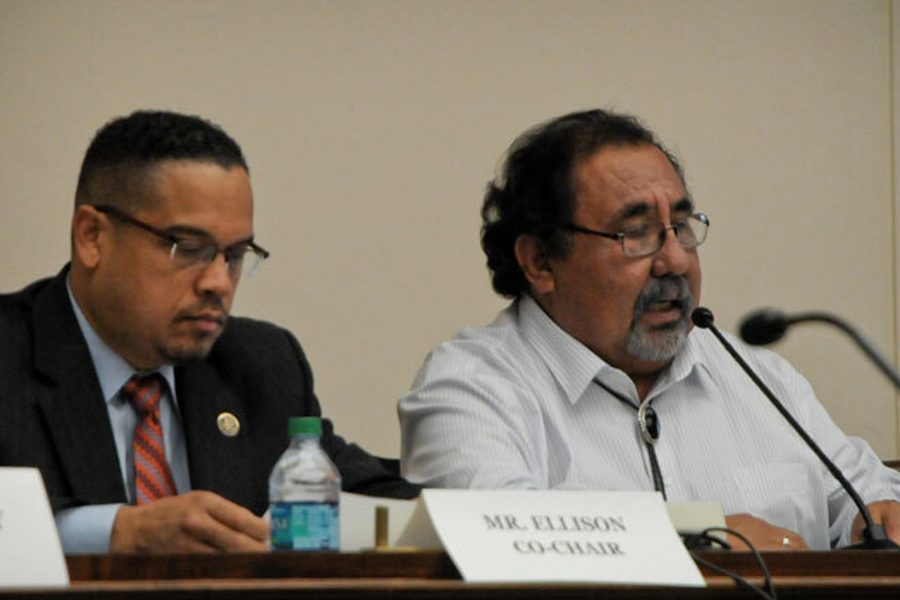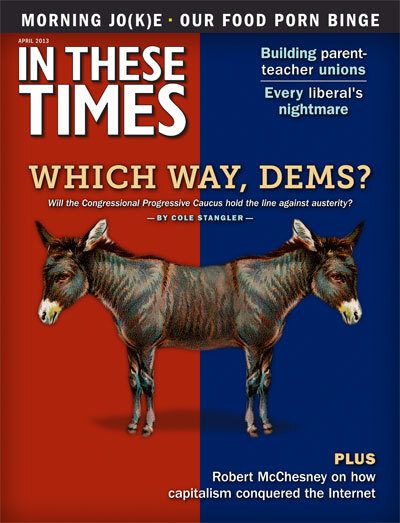Taking a Stand Against Cuts
Will the Congressional Progressive Caucus hold the line against austerity?
Cole Stangler

Tally the 500,000 government jobs Congress has cut since 2007, or the $1.5 trillion it has slashed from the federal budget since 2011, and it’s hard not to conclude that the country is in the midst of a brutal austerity regime.
The March 1 sequester triggered another $85 billion in federal cuts. But even that is unlikely to quench Washington’s thirst for austerity. Intransigent Republicans are insisting on more spending cuts, while President Barack Obama and his Democratic allies in Congress call for a “balanced approach” — cuts topped with taxes. As is often the case with budget cuts in today’s political climate, those with the least have the most to lose — the poor, the working class and those on fixed incomes.
Are any Democrats on the Hill willing to draw a line in the sand and refuse further cuts? The answer may hinge on a caucus built more than two decades ago by someone who is not, in fact, a Democrat.
An independent from Vermont
When Bernie Sanders (I-Vt.) was first elected to Congress in 1990, he was uncertain about the role he could play. As an independent without an immediate group of allies, the former socialist mayor of Burlington decided to seek out like-minded Democratic members of the House — such as Reps. Lane Evans (Ill.) (at that time Sanders’ landlord), Maxine Waters (Calif.) and Ron Dellums (Calif.), a member of Democratic Socialists of America.
“I thought that what we needed was a caucus that said ‘We are standing with the working families of this country,’” Sanders tells In These Times. “And that means we’re gonna fight for jobs. We’re gonna fight for healthcare. For education. We’re gonna fight for affordable housing. All of those issues that are relevant to the needs of low and moderate income Americans.”
The resulting Congressional Progressive Caucus (CPC) served as a forum for advancing a social democratic agenda at a time when conventional wisdom inside the Beltway held that the Democratic Party needed to move to the center. As CPC member Neil Abercrombie (D-Hawaii) said at the time: “What we have to do is stop running like Republicans and start running like Democrats again.”
The caucus made its first splash in 1995 when it responded to the Republicans’ Contract with America with a progressive alternative—a $63 billion stimulus package that included increased spending on education and health programs, infrastructure improvement, and tax cuts for working families.
With 72 members, today’s CPC is the largest Democratic caucus, and it is again proposing alternatives in a city where the notion of balancing the budget on the backs of those most in need is rarely challenged. The CPC is also spearheading Democratic opposition to cuts in Social Security, Medicare and Medicaid. And in the current legislative session, caucus members are introducing bills that would bring a more rapid end to the war in Afghanistan, impose a transactions tax on Wall Street traders to generate billions in revenue, take steps toward achieving full employment and amend the Constitution to clarify that corporations are not people.
“The progressive agenda is the majority agenda in America,” Rep. Keith Ellison (D-Minn.), co-chair of the CPC since 2011, tells In These Times. “It’s just that because of the concentration of money in politics, Congress is not responsive to the majority of Americans. They’re responsive to the money. And so when we side with the American people, it might not be the center of the Congress, but it’s the center of America.”
Of course, in today’s Congress, a leftwing caucus can only be so effective. All CPC members, with the exception of now-Sen. Bernie Sanders, are in the Republican-controlled House. This means that ambitious legislative efforts — say, Rep. Jon Conyers’ (D-Mich.) full employment bill or his “Medicare-for-all” bill — are dead on arrival.
But sometimes in Congress, victory means stopping bad things from happening. And when left-leaning legislators are backed by an energized base of outside support, such prophylactic victories are more possible. In early 2005, for instance, President Bush, invigorated by his re-election and benefiting from Republican majorities in both chambers of Congress, announced plans to privatize Social Security. That scheme failed thanks to an opposition campaign that saw a rag-tag coalition of Democratic members of Congress, labor unions, think tanks like the Campaign for America’s Future and groups such as the AARP draw a line in the sand. Similarly, progressives in Congress today could beat back regressive legislation by joining forces with their allies in civil society. With austerity battles on the horizon, opportunities for similar defensive collaborations await.
And that raises this question: Given the barriers to passing the kind of sweeping progressive legislation CPC members want, how effective is the caucus that is called “the conscience of the Democratic Party” at fighting for the values it stands for?
“If I had a dollar for every time anyone said to me, ‘Nobody is saying anything about X, Y, Z,’ I’d have a million dollars,” says Ellison. “The truth is members of the Progressive Caucus are leading on every progressive issue in America, but we need to break through the communications gap.”
Getting that word out, however, will require a change in political strategy, particularly in how progressive members of Congress and the broader progressive movement support and interact with each other.
Weak, or just patient?
A major test of the CPC’s political power is on the horizon. As part of the fiscal cliff negotiations in December 2012, the White House expressed support for a new formula to calculate cost-of-living increases for Social Security benefits — what is known as the “chained consumer price index” or “chained CPI.” This formula would effectively cut Social Security benefits, hurting in particular those seniors who rely on Social Security to pay all their bills. While chained CPI was not part of any deal to avert the March 1 sequester (since there was no deal), it is likely to be on the table in future negotiations. Alex Lawson, executive director of the D.C.-based Social Security Works, says he fears that chained CPI could come up as part of a “grand bargain” on deficit reduction.
“The White House has gone out of its way to make sure that everybody knows that chained CPI is very much on the table,” Lawson said. “This isn’t something the Republicans are putting on the table that the administration would have to reluctantly accept. This is being offered by the administration.” In the halls of Congress, the CPC leads the opposition to chained CPI. On February 15, CPC Co-Chairs Ellison and Rep. Raúl Grijalva (D-Ariz.) released a letter opposing any cuts to Social Security, Medicare or Medicaid. Signed by 107 House Democrats, including a substantial number of non-CPC members, the letter has the support of the majority of the Democratic caucus. However, another group of representatives has drawn an even firmer line in the sand. In a separate letter authored by Reps. Alan Grayson (D-Fla.) and Mark Takano (D-Calif.), 30 lawmakers, including 25 CPC members, have pledged to vote “no” on any bill that cuts any of the three programs.
Ellison, who signed both letters, defends the CPC’s less strongly worded letter: “There’s no separation between me and Alan [Grayson] on this issue, but other members want to see a more fully fleshed out deal before they make a hard fast line on what they’re going to support and what they won’t support.” Grijalva, who also signed both letters, echoes that sentiment.
Nevertheless, it does not bode well that only 34 percent of CPC members have signed on to the Grayson letter. That suggests that some caucus members are prepared to vote for some form of benefit cuts. What’s more, the discrepancy in numbers between the two letters undermines the bargaining power of the signatories to the more moderate one. Consequently, when the White House, Republicans and Democrats negotiate the details of any potential “grand bargain,” they might have reason to question the CPC’s opposition to Social Security cuts — particularly given the caucus’s track record.
In the summer of 2009, when the so-called “public option” seemed like a possibility for healthcare reform, the then-co-chairs of the CPC, Grijalva and Rep. Lynn Woolsey (D-Calif.), sent a letter to the president saying that they would not vote for a bill that did not include a “robust public option.” The Democratic-majority House did eventually pass a bill with a scaled-back public option in November 2009. But in March 2010, when the Affordable Care Act went back to the House after being stripped of any public option by the Senate, every member of the CPC voted in favor of it. The final bill passed by a slim 219 to 212, with the CPC casting the deciding votes.
A senior Hill aide told In These Times that the way the Progressive Caucus handled the healthcare debate seriously damaged its credibility. The aide is worried that when push comes to shove, CPC members may fall in line with the White House and the rest of the Democratic Party by voting for a budget that includes benefit cuts.
Cathy Hurwit, chief of staff for longtime CPC member Rep. Jan Schakowsky (D-Ill.), brushes away concerns that the healthcare debate damaged the CPC’s bargaining power. “I think the caucus is taken very seriously,” says Hurwit. “Caucus members take positions that they feel are the right ones to make. And I think voting for Obamacare was the right thing to do.”
Dave Swanson, a co-founder of the anti-Iraq war coalition After Downing Street, points to the CPC’s opposition to the Iraq War as another instance of its damaged credibility. In 2007, the caucus said it would no longer vote for bills that included funding for the war that wasn’t tied to troop withdrawal — a pledge many CPC members abandoned.
“You can understand why nobody takes [the CPC] seriously — because they have this track record,” says Swanson. “I cringe when [they] put out a tough statement or press release or public commitment to anything.”
Getting out of the House
But the CPC’s current leadership, as embodied in Ellison and Grijalva, provides reason to believe the caucus can hold the line on Social Security — or at least proactively pursue progressive principles. Both Grijalva and Ellison, who have served together since January 2011, are committed to building inter-caucus unity and — most significantly — nurturing connections with the grassroots of the progressive movement.
Ellison sees the caucus not only as an umbrella organization for left-leaning members on Capitol Hill and their allies, but ultimately a legislative powerhouse in Washington.
“Historically the Blue Dog caucus [of conservative Democrats] has been able to parlay their agenda into action by threatening to vote with the Republicans,” says Ellison. “Most people want to protect Social Security, Medicare, Medicaid. Most people believe the minimum wage should be much higher. Most people believe that we should have sane, sensible controls on guns. The real challenge is organizing and making sure that progressive America, which is organized, knows that there are at least [72] people in Congress who agree with them, who feel they’re right and are willing to fight for them.”
To this end, the CPC has been active like never before.
In the summer of 2011, CPC members, supported by SEIU and Change to Win, went on a “Speakout for Good Jobs Now” tour to eight cities. The caucus has plans to roll out a similar jobs tour this year.
In each of the past three years, the CPC has organized a summit to build ties with the progressive community. The most recent event, in January, was attended by more than 100 organizations, according to Charles Chamberlain, executive director of Progressive Congress, a non-profit that provides staff support, organizing assistance and consulting to the CPC. Organizations attending the summit included SEIU, CWA, the AFL-CIO, the NAACP, Democracy for America, the Sierra Club and Green for All. Also participating was Progressive Democrats of America (PDA), a group that engages in what it calls an “inside-outside” strategy to bridge the divide between social movements and sympathetic members of Congress.
Tim Carpenter, PDA’s national director, says that his organization’s relationship with the caucus has improved under the caucus’s new leadership, which, in addition to Ellison and Grijalva, includes CPC Executive Director Brad Bauman, who came on board in 2011.
In December, PDA began hosting monthly roundtable discussions on Capitol Hill where caucus members and their staff meet with representatives from labor, peace, environmental and other progressive groups to discuss legislation and upcoming campaigns.
“We want to imbue a sense of activism to the caucus,” says Bauman.
Carpenter appreciates that. “Our role now is [to] grow the progressive wing of the Progressive Caucus and get those other members of the CPC to step up,” says Carpenter. “There are over 50 CPC members that still haven’t signed the Grayson letter on holding the line on Social Security. That’s unconscionable. … That number should be much higher.”
Another key challenge to the effectiveness of the caucus — one that seems an inevitable result of being embedded within a larger political party — is the lack of enforcement mechanisms to ensure members work together. In the end, members simply have more loyalty to their party than their caucus. CPC members do deduct a small portion of their salaries in order to pay the salary of the group’s executive director, Bauman, but beyond that, there are no formalized institutional links that bind members together. The CPC cannot, for instance, kick out members for voting a certain way.
“There were times when members couldn’t vote with the caucus,” says former Rep. Pete Stark (D-Calif.), a member of the CPC from the mid-1990s until he left Congress in January after losing his bid for re-election. “There were others who didn’t want to go against the Democratic leadership, and so, you never have 100 percent. You had no way to enforce it, other than people pressuring other members. It was a good group of friends, who had a like mind on a variety of issues, but beyond that, there was no enforcement mechanism.”
Ellison acknowledges that the lack of such a mechanism poses “a challenge.” But, he says, during the 112th Congress the CPC fostered unity by holding “mini-filibusters” in which CPC members took to the floor of the House to speak against Republican efforts to gut Medicare and oppose job creation.
Those mini-filibusters — an attempt to move the debate leftward and establish CPC’s mark on Congress — demonstrate that the CPC can flex its muscle using traditional legislative tactics. (The mini-filibusters are available on the Progressive Caucus YouTube channel.)
From symbol to substance
In the context of a debt-obsessed Congress, in recent years the caucus is best known for its budget proposals — the People’s Budget for FY2012 and the Budget for All for FY2013. According to Grijalva, these efforts have both increased the caucus’s overall visibility and built solidarity among caucus members as their staffs work together to craft and defend a common fiscal vision — an exercise in cooperation that harkens back to 1995 and the CPC’s opposition to the Contract with America.
Indeed, the CPC’s budgets have stood in marked contrast to the other budget proposals on the table — not only the ultraconservative budgets of Rep. Paul Ryan (R-Wis.) that dismantle the social safety net, but also the technocratic, neoliberal budgets of the Obama administration. For example, the CPC’s 2012 Budget for All advocated taxing all capital gains, implementing a more progressive tax code, slashing military spending, and eliminating corporate welfare for oil, gas and coal companies — all proposals that have popular support.
“For a while, the Progressive Caucus had built a reputation for being the conscience of Congress,” says Grijalva, who was elected in 2002. “For leading the symbolic fight, whether it was [opposing] funding for the war [or] talking about issues that were not politically in vogue and nobody wanted to talk about. … I think [the budget] allowed us now to be more than just those good, nice, smart lefties that are always gonna say the right thing — somebody who’s proactively proposing an alternative, even to the Democratic Caucus.”
Those budgets, while they may not have much of an immediate impact on fiscal votes in Congress, ultimately boost the visibility and legitimacy of the caucus in the long run. For one, the budgets send a strong message to the rest of the Democratic Party that there is a section of the party with a markedly different economic agenda than the one shared by the President and many in Congress. They also allow the CPC to build partnerships with outside groups that work to craft and promote those proposals. Finally, the CPC is building a reputation among the public at large as the only real opponent of austerity in Washington. If the CPC can continue to make those partnerships and get out its message, more Democrats may, eventually, feel like they have to join.
“Now we’re at a point where we’re not just the necessary conscience of the Democratic Party in Congress, but we are a significant source of either support or opposition for a proposal,” says Grijalva, confident his 72-member voting bloc will play a major role in any budget deal that goes before Congress.
The progressive future
Looking ahead, the CPC is most likely to gain clout if Democrats regain control of the House in the 2014 election, which would mean caucus members would become committee chairs. But first, in spite of the optimistic talk of a future “permanent Democratic majority,” the Democratic Party as a whole must overcome obstacles such as gerrymandered congressional districts and the more recent wave of voter ID restrictions. The caucus would also benefit from the election of more progressive Democrats, but that process has its own hurdles. It takes millions of dollars to seriously compete in a congressional race, and unlike Republicans or those Democrats from the neoliberal wing of party, progressive Democrats have a limited monetary base.
That money gap has ramifications for progressives inside Congress, as well. The infrastructure supporting the progressive wing of the party pales in comparison to the hundred-million-dollar-plus budget of the Heritage Foundation or the Tea Party-bankrolling Freedom Works, and indeed even the corporate-funded Progressive Policy Institute, the think tank of the now defunct Democratic Leadership Council.
“You need progressive institutions, clearly, which can both help to elect candidates and also push the system as a whole more to the left. We have some of those institutions,” said Michael Kazin, editor of Dissent magazine and history professor at Georgetown University. “The keyhole, of course, is organized labor, which used to be essential to this.”The general political environment is thus far from hospitable. This is no secret on the Left. On the other hand, what shouldn’t be underestimated is how critical the next two years are for defending the social safety net and keeping a progressive agenda relevant on the national level. Grijalva put it very simply: “Anything in politics in D.C. is about results; the ability to get something done or stop something bad from happening.”
With austerity looming, the CPC will have plenty of chances to do the latter in today’s Congress. The chained CPI debate could mark a major test of the caucus’s ability to influence negotiations and act as a cohesive voting bloc. But even given the unavoidable reality of budget cuts, CPC members have an opportunity to influence what’s targeted in a given piece of legislation — for example, their insistence on slashing the Pentagon’s bloated spending could pay off, even if it’s ultimately in a scaled-back fashion. And as the caucus continues to take steps to build its clout and gain new members, it will continue to have a bigger voice in those ongoing negotiations and help drive the budget debate to the left.
If the caucus leadership and members can manage to do all of these things successfully — no short order — and the next two election results are favorable to the Left, the Progressive Caucus could be playing a drastically different role in a future Congress. Instead of being forced to defend the gains of the 20th century, it could actually be advancing a progressive agenda for the 21st.









